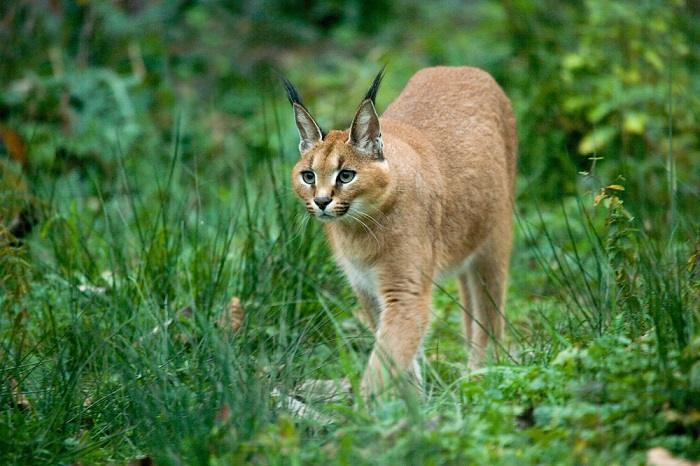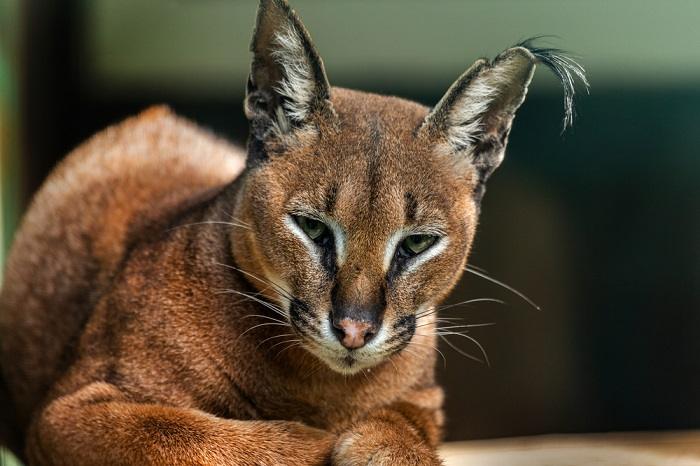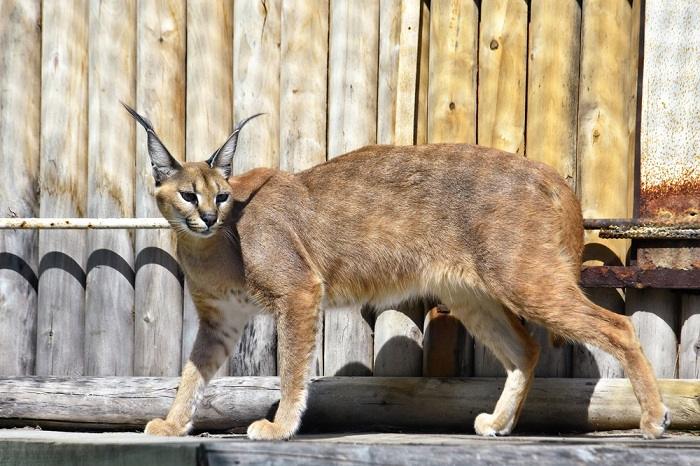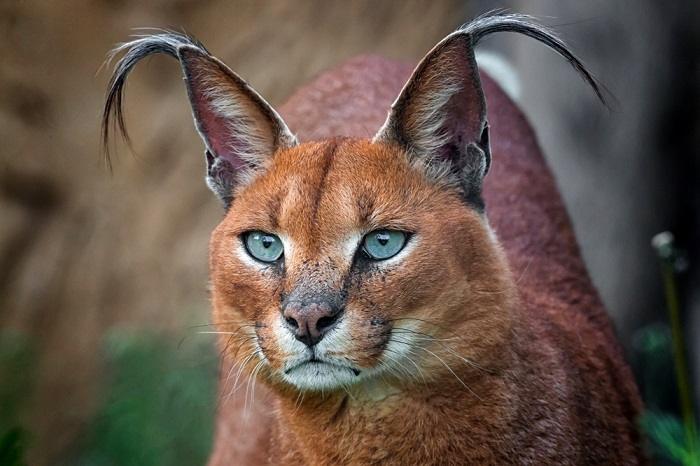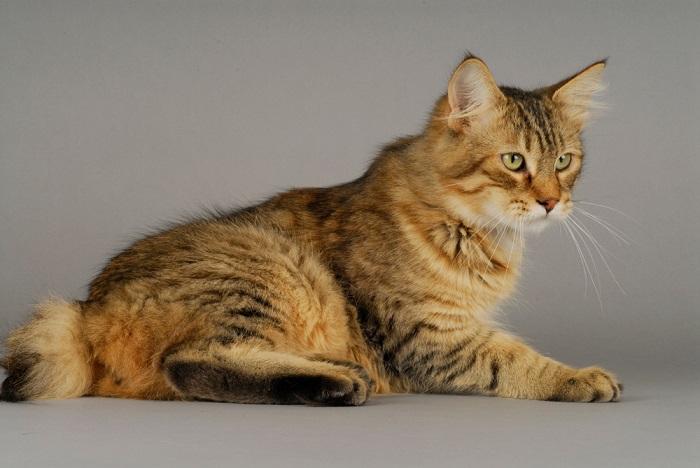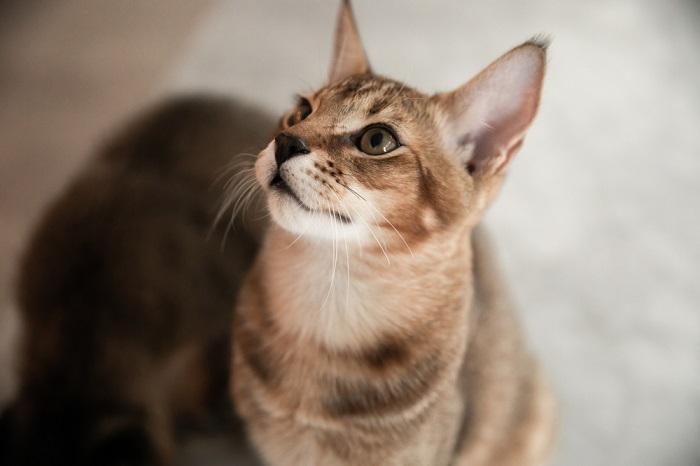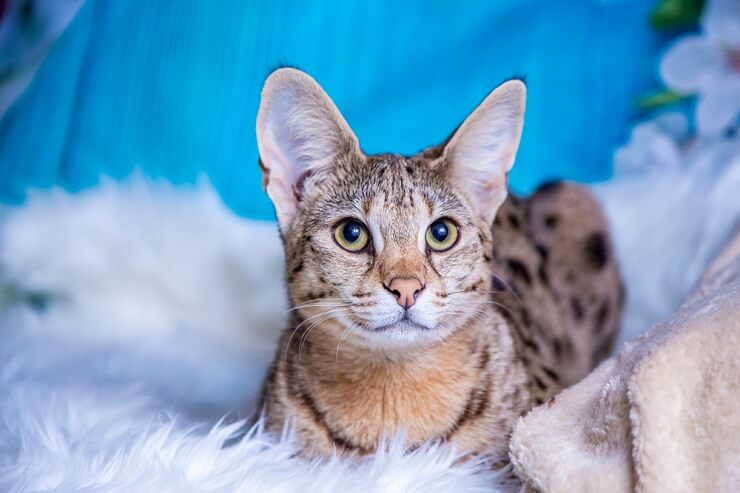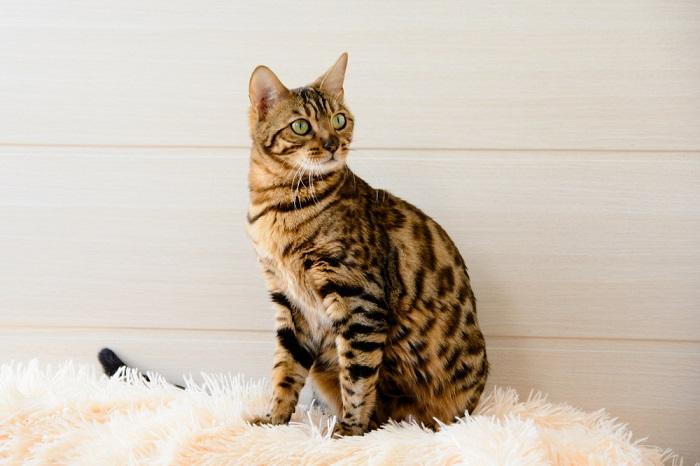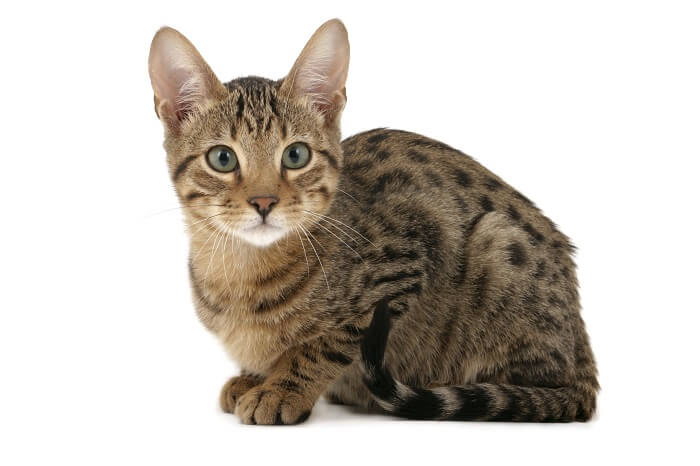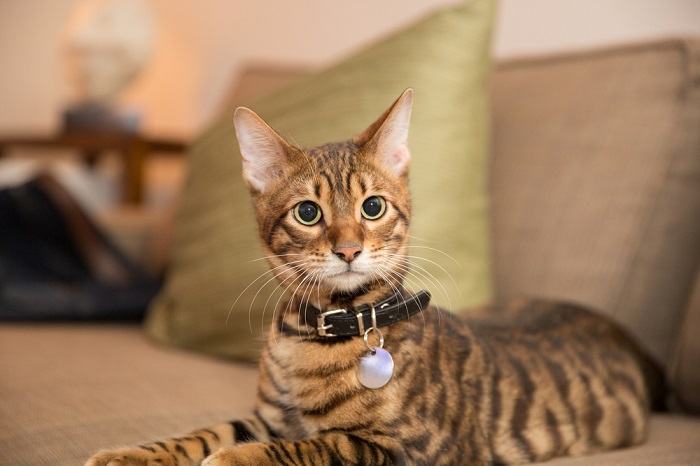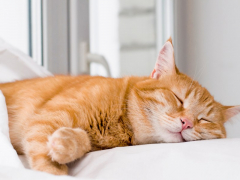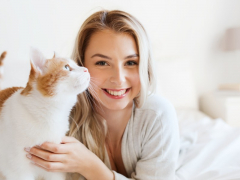The caracal (Caracal caracal) is a species of wild cat. The caracal is sometimes called the desert lynx, though it is not a true lynx. There are three subspecies of caracal: the Southern caracal (C. c. caracal), which is found in South Africa and East Africa; the Northern caracal (C. c. nubicus), which is found in North and West Africa; and the Asiatic caracal (C. c. schmitzi), found in Central Asia and India. Caracals are also found in the Middle East.
The caracal is a small wild cat species found in Africa, Central Asia, India, and the Middle East. As wild animals, caracals are territorial, messy, and can be aggressive. Wildlife experts strongly warn against keeping caracals as pets, even if it is legal to do so in your state.Key Takeaways
The caracal has long legs, a short, tan or sandy colored coat and large, tufted ears. The black ear tufts are especially striking on this beautiful wild cat, which looks a bit like a cougar in miniature. Though small for a wild cat, caracals are quite a bit larger than most house cats. Adult caracals weigh about 20 to 40 pounds.
Some people say that caracals are good pets and some breeders even raise and sell caracals at high prices. Owning a wild cat like a caracal sounds exciting, but is it a good idea? Do caracals really make good pets?
The short answer is no, caracals are best left in the wild. To find out why, let’s explore the cat family to learn what makes caracals different from domestic cats, and less suitable for life as pets.
Exploring The Cat Family
Like all members of the subfamily Felinae, caracals can purr but cannot roar like the big wild cats.
All cats, both wild and domestic, belong to the Felidae family. The Felidae family is further split into two subfamilies, Pantherinae and Felinae.
The subfamily Pantherinae contains seven big cat species, which are classified into two genera, Panthera and Neofelis. The subfamily Pantherinae includes seven wild cat species:
- Lion (Panthera leo)
- Tiger (Panthera tigris)
- Jaguar (Panthera onca)
- Leopard (Panthera pardus)
- Snow leopard (Panthera uncia)
- Mainland clouded leopard (Neofelis nebulosa)
- Sunda clouded leopard (Neofelis diardi)
The subfamily Felinae is much larger, containing many different species of wild cats, as well as our domestic house cats. Some of the most common members of this subfamily include:
- African wildcat (Felis lybica)
- Asian golden cat (Catopuma temminckii)
- Bobcat (Lynx rufus)
- Caracal (Caracal caracal)
- Cheetah (Acinonyx jubatus)
- Cougar or mountain lion (Puma concolor)
- Domestic cat (Felis catus)
- Jungle cat (Felis chaus)
- Leopard cat (Prionailurus bengalensis)
- Ocelot (Leopardus pardalis)
- Serval (Leptailurus serval)
Most of the species in the subfamily Feliane are small cats compared to the big cats found in Pantherinae. Two of the larger Feliane cats are the cheetah and cougar.
All members of the subfamily Pantherinae (except for the snow leopard) can roar but they cannot purr like our house cats do. On the flip side, all members of the subfamily Felinae can purr but they cannot roar like the big cats. This is because Pantherinae cats have a flexible hyoid, which is a small bone in the throat close to the larynx. Felinae cats have bony hyoids, which allow purring but not roaring.
Also Read: 15 Little-Known Facts About Big Cats
Are Caracals Related to Domestic Cats?
Even though they are related to domestic cats, caracals remain wild, even when raised in captivity.
Caracals and domestic cats are members of the same subfamily, so they are somewhat closely related. You might think this means that caracals can easily be tamed just like cats, however, this is not the case. Caracals are wild animals, and retain wild instincts even when living in captivity.
To compare, the subfamily Felinae contains many other cats that are closely related to domestic cats but are clearly unsuitable as house pets. We wouldn’t think of bringing home a cheetah or cougar kitten to raise as a pet.
Also Read: 7 Similarities Between Domesticated Cats And Big Cats
Do Caracals Make Good Pets?
As wild animals, caracals are territorial, messy, and can be aggressive.
You might have read about people who breed caracals and sell the kittens, or maybe you’ve seen rescued caracals that are kept as pets on social media. It sounds exciting to keep one of these beautiful creatures as a pet, but wildlife educators strongly advise against this practice for many reasons.
Caracals, even those bred purposely to be pets, are still wild animals. They are unpredictable and can even be dangerous. A caracal’s wild instincts can be triggered at any time, and this can include aggressive behavior toward humans, especially children, as well as other pets. Caracals are large, strong animals with powerful jaws, and sharp teeth and claws. Even just one instance of aggression can do serious damage, especially to a child, an elderly person, or another pet.
Caracals are also extremely territorial and messy. Many pet caracals are kept in special outdoor enclosures, not only for the safety of people and pets, but also because caracals can cause a lot of damage when they act on their normal behaviors like scratching, spraying urine, and defecating out in the open.
If you keep a caracal as a pet, it might be tough to find a veterinarian who is willing to handle the cat, which will need preventive care and vaccines, and might need treatment if your caracal ever becomes injured or sick. It might be necessary to search out a wild animal veterinarian that treats exotic cats; this can be expensive and might entail traveling far from your home.
Feeding caracals is difficult and expensive because they are carnivores and need a very specific, specialized diet, possibly including raw meat. In the wild they catch birds and also eat rodents, hyraxes, hares, and even small antelopes and gazelles.
Most important, all wild animals, including caracals, are happier in their natural habitat. Unlike domestic cats, which have happily lived side by side with humans for thousands of years, caracals are not meant to cohabitate with humans. Caracals can’t fully express their natural instincts in safe and appropriate way when they are living in a human environment rather than in the wild.
Also Read: 12 Cat Breeds With Adorable Big Ears
Is It Legal to Keep a Caracal As A Pet?
Depending on what state you live in, owning wild animals like caracals might not be legal. Though some states allow you to keep wild animals as pets, you might need to apply for a special license or permit. Some states ban the ownership of all wild animals, including caracals.
Some states have no laws concerning the ownership of wild animals, so it might be legal. However, even if owning caracals is not banned outright doesn’t make it a wise choice.
Cat Breeds That Only Look Wild
If you like the exotic look of a caracal, but know it’s best to stick to domesticated cats for pets, some cat breeds have been developed that are wild in looks but are docile pets happy to live with people. Some of these breeds are what are called hybrids, which means they were created in part using a wild cat species in the early stages of breed development.
However, the hybrids mentioned below are fully established breeds accepted by The International Cat Association (an international all-breed cat breed registry), and are far removed from their wild relatives. Some of the breeds listed below were created using hybrid breeds and domestic breeds, so they look exotic but have very little wild blood.
Pet owners looking for a wild pet in looks only, one that is gentle and friendly in temperament, can consider these cat breeds that look exotic, but act just like domestic cats:
Also Read: 101 Wild And Exotic Cat Names
#1 Pixie-Bob
Though some people claim that the Pixie-Bob was created by crossing a bobcat with a domestic cat, this is simply untrue. The breed was founded with a large, classic-patterned male cat with a short tail and another domestic female cat. One kitten from the litter, named Pixie, had a reddish-fawn coat and a wild look.
The owner of this kitten was so enamored with her look that she sought to create a breed of bobtailed cat with a wild appearance. The Pixie-Bob is loving, active, and social, and has been described as doglike.
#2 Chausie
The Chausie (pronounced chow-see) is great for people who are drawn to the look of the caracal, as this breed comes in a sandy, reddish-brown or gray fur that looks a lot like the caracal’s coat. The Chausie is a hybrid breed developed in the 1990s by crossing a small, wild cat called the jungle cat (Felis chaus) with domestic cats.
One of the Chausie’s three color patterns, black grizzled ticked tabby, is unique and comes directly from the jungle cat. The Chausie is active, athletic, and sociable.
#3 Savannah
The Savannah is a hybrid breed that was developed using the African serval and domestic cats. The serval (Leptailurus serval), is a small wild cat native to Africa that has a slender body, small head, and large ears. The Savannah is curious, outgoing, and assertive. The breed likes playing in water and needs lot of exercise and mental stimulation to be happy.
#4 Bengal
The Bengal is another hybrid breed that was developed by breeding domestic cats with the Asian leopard cat (Prionailurus bengalensis). The Bengal has a beautiful and unique coat pattern. Some Bengal coats feature special spots called rosettes, reminiscent of the markings seen on leopards, jaguars, and ocelots. Bengals are energetic, outgoing, curious, and affectionate.
Also Read: 5 Important Facts Things To Keep In Mind Before Getting A Bengal Cat
#5 Serengeti
Though it was developed to look like the wild African serval, the Serengeti contains no serval blood. The breed was created using Bengals and Oriental Shorthairs. The very small amount of wild cat blood found in the Serengeti comes from the Bengal, which itself was created using the Asian leopard cat.
The Serengeti is confident, friendly, and active. This talkative breed likes to meow at its people to communicate.
Also Read: 12 Rare Coat Colors and Patterns In Cats
#6 Toyger
Though it was developed to look like a tiger in miniature, the Toyger has very little wild cat blood. The breed was initially created using a domestic cat, a Bengal, and a street cat from India. The Toyger was eventually standardized, the breed’s beautiful coat displaying a bold vertical stripped pattern and circular markings on the head similar to the markings found on a tiger.
The very small amount of wild cat blood in the Toyger comes from the Bengal, which was created using the Asian leopard cat. The Toyger is docile, smart, and very friendly.
Also Read: 7 Exotic Cat Breeds That Look Like Leopards
Frequently Asked Questions
Are caracals friendly to humans?
Caracals are wild animals and are not included to be friendly toward humans. In the wild, caracals are solitary animals that prefer to live alone. Even caracal kittens bred to be sold as pets still have wild instincts, including an aversion to humans.
Is a caracal cat aggressive?
Caracals, even those bred to be sold as pets, retain their wild instincts. They can be aggressive toward humans and other animals like pet cats and dogs. Although caracals raised from kittens might learn to live with humans, these are still wild felines and can be extremely unpredictable, even dangerous.
Like housecats, caracals will make sounds that warn of impending aggression, including growls and hisses. Attempting to tame a caracal found in the wild is recommended by wildlife experts.
Can a caracal hurt you?
Caracals are small, so caracal attacks on humans are rare, however they do happen on occasion, especially when people keep these exotic animals as pets. Any wild animal, including caracals, can be dangerous if cornered. Caracals are more likely to hurt children and the elderly, and can injure or even kill other pets like cats and dogs.
How much does a caracal cost?
Breeders raise and sell caracals as pets, and they can cost exorbitant amounts. Wildlife experts strongly warn against keeping caracals as pets, even if it is legal to do so in your state.

